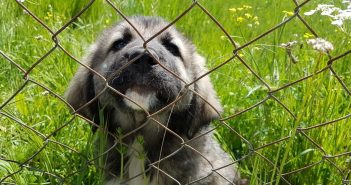Ozzie, my four-month old Rottweiler peered up at me with his big brown eyes, as I temporarily left him for a very important surgical procedure. As much as it broke my heart to drop off my “baby” at the local humane society, I know it was the responsible thing to do.
What Ozzie doesn’t know is that today is the first day of the rest of his life. He is being neutered. Being a rescue volunteer, I’ve acquired a rather large brood of dogs into my family circle. Having adopted six boys and two girls of the canine species, I’ve come to complete understanding of the importance of spaying and neutering our furry companions.
Persons who come in contact with me and my animals will ask, “how can you spay and neuter these beautiful animals? You could breed them and make a profit.”
When I encounter these folks, I tend to get a little testy and become a bit wordy with an explanation to the multiple reasons behind my choice as a responsible pet owner:
- All animals are beautiful, but unless an individual has the time, funding or resources to “breed” puppies, it is not a good idea to permit one’s animals to produce offspring that may end up in a “puppy mill” environment. (For more information on “Puppy Mills,” go to www.puppymillrescue.com)
Spaying or neutering is a fairly inexpensive procedure if done at your local shelter or Humane Society Spay or Neuter Clinic. Furthermore, spaying and neutering has minimal risks and is one of the most common, animal surgical procedures. - A spayed or neutered animal behaves better. While unsterilized males tend to roam in search of a mate, they risk injury or death due to traffic and fight incidents. They also tend to mark territory with urine, and can be quite embarrassing when they decide to mount objects and human legs when excited. Unsterilized females will also roam, have bloody discharge, will yowl and urinate more often during heat cycles; and have a tendency to tear or chew their way out of an enclosure. Neutered or spayed dogs and cats focus primarily on their human counterparts and do not exhibit behavior patterns as mentioned above. (For the address of your local Humane Society, click here: www.napcc.aspca.org.)
- My main reason for spaying or neutering: Spayed or Neutered animals live longer, healthier lives. “…By neutering a male cat or dog before six months of age prevents testicular cancer and prostate disease. Spaying a female cat or dog helps prevent pyometra and breast cancer…” (Facts from ASPCA? “Why Spay or Neuter?” Flyer) Additionally, spaying or neutering your animals can prolong their lives by an average of two to three years.
- Responsibility. Millions of animals needlessly suffer and die every year. Why? Everybody loves cuddly puppies and cute kittens, but when these once-adorable babies grow up, children and adults, alike may lose interest in caring for them. Usually, these animals end up in shelters where they may be euthanized – or worse, get “put out” where they end up as strays. Strays, unfortunately, may die from starvation, disease, weather exposure or being hit by traffic.
When I was younger, I used to watch Bob Barker’s “The Price is Right” on television. At the end of each and every show, I candidly recall Mr. Barker reiterating, “Help control the pet population, have your pets spayed or neutered today.” What a profound and responsible statement that is. You see, if you do your part by helping control the pet population, you may just save a life. Do you love your animal companion(s)? I do.

© 2004 – All Rights Reserved
C. Bailey-Lloyd/LadyCamelot is the Public Relations Director & Writer for Holistic Junction — Your source of information for Holistic Practitioners; Naturopathic Schools, Massage Therapy Schools, and Reflexology Schools; Alternative Healthcare; Insightful Literature and so much more!



